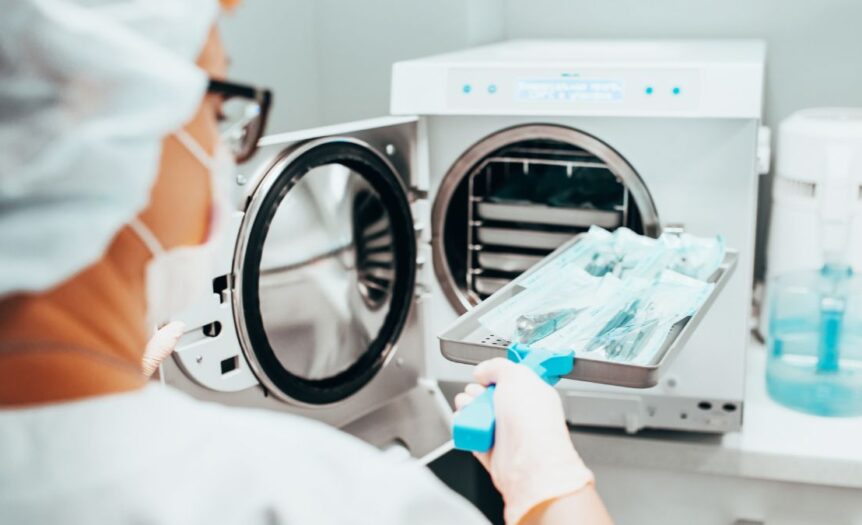Medical devices are essential in hospitals, clinics, and other healthcare facilities. However, they can be a source of infection in patients if you don’t follow cleaning and sterilization procedures. Cleaning and sterilization are crucial for preventing healthcare-associated infections, which can cause serious harm to patients.
Let’s discuss five ways medical devices are cleaned and sterilized to ensure the safety of patients and healthcare workers.
Manual Cleaning and Disinfection
Manual cleaning is the most basic method of disinfecting medical devices. This method involves physically scrubbing the device with a cleaning agent and rinsing it with water to remove residual debris. The next step is to apply a disinfectant solution to the cleaned device and let it sit for a specified period to destroy any remaining microorganisms. Finally, the device is rinsed with water to remove the disinfectant. Though this method is labor-intensive and time-consuming compared to other methods, it can effectively clean and disinfect simple medical devices.
Ultrasonic Cleaning
Ultrasonic cleaning is a relatively new method of cleaning medical devices that involves immersing the device in a cleaning solution. At the same time, ultrasound waves create high-frequency pressure waves to loosen and remove debris. The process uses an ultrasonic cleaning machine, a transducer, to convert electrical energy into mechanical vibrations. The resulting cavitation bubbles created by the vibrations can penetrate hard-to-reach areas of the tool, such as crevices, cracks, and joint spaces, removing even the most stubborn debris.
Steam Sterilization
Steam sterilization is the most common method of sterilizing medical devices. This method uses high-pressure steam to kill microorganisms on the device’s surface and lumen. The device is wrapped in a packaging material and placed in an autoclave that uses high-pressure steam to generate heat reaching up to 121 degrees Celsius. The heat and pressure destroy all microorganisms on the device.
Ethylene Oxide Sterilization
Ethylene oxide (EO) sterilization is a low-temperature method that uses ethylene oxide gas and steam to sterilize medical devices. EO gas can penetrate the device’s packaging and kill microorganisms that reside inside the device’s lumen. Although this method is effective, it requires several hours to complete, and there is always a risk of toxic residue remaining on the device.
Hydrogen Peroxide Sterilization
Hydrogen peroxide (H2O2) sterilization is a relatively new medical device cleaning method. The process involves placing the device in a chamber filled with hydrogen peroxide gas. The gas penetrates the device’s packaging and activates, breaking down lingering microorganisms’ cell walls and killing them. Then, the chamber aerates to remove any toxic residue.
Maintaining clean and sterile medical devices is crucial for preventing healthcare-associated infections. Strict adherence to cleaning and sterilization procedures is just one consideration for reusable medical device design. By following the cleaning and sterilization methods mentioned here, healthcare facilities ensure their medical devices are safe and protect patients and healthcare workers.










 Deering Estate
Deering Estate
 Massage Envy South Miami
Massage Envy South Miami
 Calla Blow Dry
Calla Blow Dry
 My Derma Clinic
My Derma Clinic
 Sushi Maki
Sushi Maki
 Sports Grill
Sports Grill
 The Healthy Kitchen
The Healthy Kitchen
 Golden Rule Seafood
Golden Rule Seafood
 Malanga Cuban Café
Malanga Cuban Café

 Kathleen Ballard
Kathleen Ballard
 Panter, Panter & Sampedro
Panter, Panter & Sampedro
 Vintage Liquors
Vintage Liquors
 The Dog from Ipanema
The Dog from Ipanema
 Rubinstein Family Chiropractic
Rubinstein Family Chiropractic
 Your Pet’s Best
Your Pet’s Best
 Indigo Republic
Indigo Republic




 ATR Luxury Homes
ATR Luxury Homes


 2112 Design Studio
2112 Design Studio
 Hamilton Fox & Company
Hamilton Fox & Company
 Creative Design Services
Creative Design Services
 Best Pest Professionals
Best Pest Professionals
 HD Tree Services
HD Tree Services
 Trinity Air Conditioning Company
Trinity Air Conditioning Company
 Cisca Construction & Development
Cisca Construction & Development
 Mosquito Joe
Mosquito Joe
 Cutler Bay Solar Solutions
Cutler Bay Solar Solutions


 Miami Royal Ballet & Dance
Miami Royal Ballet & Dance
 Christopher Columbus
Christopher Columbus
 Pineview Preschools
Pineview Preschools
 Westminster
Westminster
 Carrollton
Carrollton
 Lil’ Jungle
Lil’ Jungle
 Frost Science Museum
Frost Science Museum
 Palmer Trinity School
Palmer Trinity School
 South Florida Music
South Florida Music
 Pinecrest Orthodontics
Pinecrest Orthodontics
 Dr. Bob Pediatric Dentist
Dr. Bob Pediatric Dentist
 d.pediatrics
d.pediatrics
 South Miami Women’s Health
South Miami Women’s Health

 The Spot Barbershop
The Spot Barbershop
 My Derma Clinic
My Derma Clinic




 Miami Dance Project
Miami Dance Project

 Rubinstein Family Chiropractic
Rubinstein Family Chiropractic
 Indigo Republic
Indigo Republic

 Safes Universe
Safes Universe
 Vintage Liquors
Vintage Liquors
 Evenings Delight
Evenings Delight





 Atchana’s Homegrown Thai
Atchana’s Homegrown Thai
 Baptist Health South Florida
Baptist Health South Florida

 Laser Eye Center of Miami
Laser Eye Center of Miami
 Visiting Angels
Visiting Angels
 OpusCare of South Florida
OpusCare of South Florida

 Your Pet’s Best
Your Pet’s Best





 HD Tree Services
HD Tree Services
 Hamilton Fox & Company
Hamilton Fox & Company


 Creative Design Services
Creative Design Services